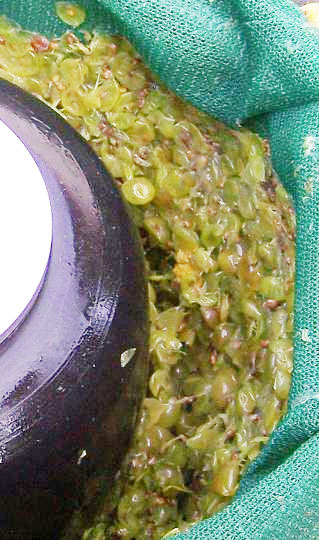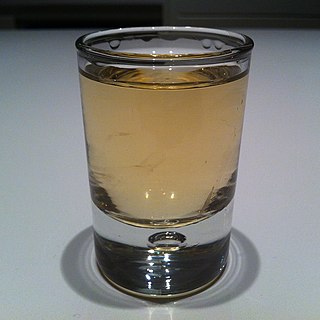
Brandy is a liquor produced by distilling wine. Brandy generally contains 35–60% alcohol by volume and is typically consumed as an after-dinner digestif. Some brandies are aged in wooden casks. Others are coloured with caramel colouring to imitate the effect of aging, and some are produced using a combination of aging and colouring. Varieties of wine brandy can be found across the winemaking world. Among the most renowned are Cognac and Armagnac from south-western France.
Ouzo is a dry anise-flavored aperitif that is widely consumed in Greece. It is made from rectified spirits that have undergone a process of distillation and flavoring. Its taste is similar to other anise liquors like pastis, sambuca, rakı and arak.

Tsipouro is an un-aged brandy from Greece and in particular Thessaly, Epirus, Macedonia. Tsipouro is a strong distilled spirit containing 40–45% alcohol by volume and is produced from either the pomace or from the wine after the grapes and juice have been separated. Tsipouro is typically produced in two varieties: anise-flavored, which is the default, and pure, which contains no anise and is specifically labeled as 'without anise.' While tsipouro is usually not aged in barrels, barrel-aged versions are also available. It is similar to tsikoudia produced on the island of Crete, but unlike tsikoudia, which is single-distilled and contains no additional flavorings, tsipouro is typically double-distilled and frequently includes spices, primarily anise.
Rakija, rakia, rachiu, rakı or rakiya, is the collective term for fruit spirits popular in the Balkans. The alcohol content of rakia is normally 40% ABV, but home-produced rakia can be stronger.

Pomace, or marc, is the solid remains of grapes, olives, or other fruit after pressing for juice or oil. It contains the skins, pulp, seeds, and stems of the fruit.

Pomace spirit is a liquor distilled from pomace that is left over from winemaking, after the grapes are pressed. It is called marc in both English and French, but "grappa" in Italian and "bagaço" in Portuguese. In Spanish it is called orujo. Alcohol derived from pomace is also used as the traditional base spirit of other liquors, such as some anise-flavored spirits. Unlike wine brandy, most pomace brandies are neither aged nor coloured.

Aguardente (Portuguese), or aguardiente (Spanish), is a type of distilled alcoholic spirit that contains between 29% and 60% alcohol by volume (ABV). It is a somewhat generic term that can refer to liquors made from various foods. It originates from and is typically consumed on the Iberian Peninsula and in Iberian America.

Liquor is an alcoholic drink produced by the distillation of grains, fruits, vegetables, or sugar that have already gone through alcoholic fermentation. Other terms for liquor include: spirit, distilled beverage, booze, spirituous liquor or hard liquor. The distillation process concentrates the liquid to increase its alcohol by volume. As liquors contain significantly more alcohol (ethanol) than other alcoholic drinks, they are considered "harder." In North America, the term hard liquor is sometimes used to distinguish distilled alcoholic drinks from non-distilled ones, whereas the term spirits is more commonly used in the UK. Some examples of liquors include vodka, rum, gin, and tequila. Liquors are often aged in barrels, such as for the production of brandy and whiskey, or are infused with flavorings to form flavored liquors, such as absinthe.

Pálinka is a traditional fruit spirit with origins in the medieval Kingdom of Hungary, known under several names. Protected as a geographical indication of the European Union, only fruit spirits mashed, distilled, matured and bottled in Hungary and similar apricot spirits from four provinces of Austria can be called "pálinka", while "Tótpálinka" refers to wheat-derived beverages. Törkölypálinka, a different product in the legal sense, is a similarly protected pomace spirit that is commonly included with pálinka. While pálinka may be made of any locally grown fruit, the most common ones are plums, apricots, apples, pears, and cherries.

An eau de vie is a clear, colourless fruit brandy that is produced by means of fermentation and double distillation. The fruit flavor is typically very light.

Zivania or zivana is a Cypriot pomace brandy produced from the distillation of a mixture of grape pomace and local dry wines made from Xynisteri and Mavro grapes. The name of zivania is derived from zivana which means pomace in the Greek dialect of Cyprus. Zivania is colourless and alcoholic with a light aroma of raisins. Its alcohol content varies, with 45% by volume being the typical value. As defined by law, zivania cannot have more than 60% alcohol content. Zivania contains no sugar and has no acidity.

Orujo is a pomace brandy from northern Spain. It is a transparent spirit with an alcohol content over 50%. Its name comes from the expression "aguardiente de orujo".

Tsikoudia is an alcoholic beverage, a fragrant, grape-based pomace brandy of Cretan origin that contains 40% to 65% alcohol by volume. Tsikoudia is made by distilling of pomace, what remains of grapes pressed in winemaking. In the eastern part of Crete, tsikoudia is often informally called raki, a name originating from the Ottoman 'raki', derived from the 17th-century Arabic 'arak', meaning 'distilled'.

Chacha is a Georgian pomace brandy, clear and strong, which is sometimes called "wine vodka", "grape vodka", or "Georgian vodka/grappa". It is made of grape pomace. The term chacha is used in Georgia to refer to grape distillate. It may be also produced from unripe or wild grapes. Other common fruits or herbs used are figs, tangerines, oranges, mulberries or tarragon.
Poli Distillerie is an artisan Grappa distillery solely owned by the Poli family, founded in 1898 in Schiavon, near Bassano del Grappa, in the heart of Veneto, Italy. The distillery is currently run by Jacopo Poli together with his siblings Giampaolo, Barbara and Andrea.

Applejack is a strong alcoholic drink produced from apples. Popular in the American colonial era, the drink's prevalence declined in the 19th and 20th centuries amid competition from other spirits.
Fruit brandy is a distilled beverage produced from mash, juice, wine or residues of edible fruits. The term covers a broad class of spirits produced across the world, and typically excludes beverages made from grapes, which are referred to as plain brandy or pomace brandy. Apples, pears, apricots, plums and cherries are the most commonly used fruits.

Rakı or raki is an alcoholic beverage made of twice-distilled grape pomace and flavored with aniseed. It is the national drink of Turkey. It is popular in many Mediterranean countries and is often served as an apéritif or with seafood or meze. It is comparable to several other anise-flavored liqueurs such as pastis, ouzo, sambuca, arak and aguardiente. The alcoholic content of raki must be at least 40%. The largest producer of raki is Diageo; Yeni Rakı is the largest brand.















